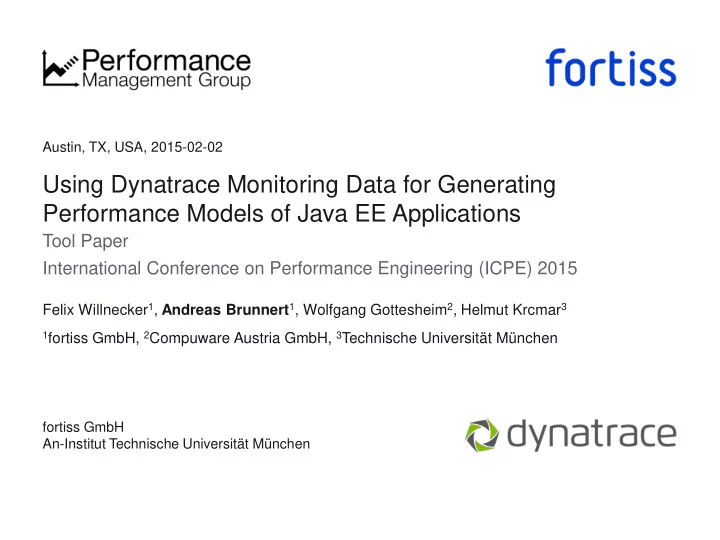

Austin, TX, USA, 2015-02-02 Using Dynatrace Monitoring Data for Generating Performance Models of Java EE Applications Tool Paper International Conference on Performance Engineering (ICPE) 2015 Felix Willnecker 1 , Andreas Brunnert 1 , Wolfgang Gottesheim 2 , Helmut Krcmar 3 1 fortiss GmbH, 2 Compuware Austria GmbH, 3 Technische Universität München fortiss GmbH An-Institut Technische Universität München
Motivation & Vision • Creating performance models requires a lot of expert knowledge – The effort required for creating performance models manually leads to a low adoption rate of model-based performance evaluations in practice (Mayer et al. 2011) • Model-based performance evaluation techniques proposed by the scientific community are often only applicable once a model of a system exists – Automated performance model generators help to make them better applicable • Several approaches were proposed to automatically construct performance models (e.g., Brosig et al. 2009 and Brunnert et al. 2013a) – Due to license restrictions or limitations of the available data they often use self- written monitoring solutions 3 pmw.fortiss.org Austin, TX, USA, 2015-02-02
Motivation & Vision • To use monitoring data collected by industry-standard Application Performance Management (APM) solutions in order to automatically construct performance models Better integration between model- and measurement-based performance evaluation techniques APM Solution , e.g., Performance Model , e.g., Dynatrace Palladio Component Model (PCM) [1] Tool [2] Focus [1] Dynatrace logo taken from: http://www.dynatrace.com/ [2] PCM logo taken from: http://www.palladio-simulator.com/about_palladio/ 4 pmw.fortiss.org Austin, TX, USA, 2015-02-02
Tool Architecture Previous Work • Builds upon an existing performance model generation framework introduced in Brunnert et al. (2013a) and Brunnert et al. (2014b) • Uses self-written monitoring components (e.g., ServletFilters, EJB Interceptors) in order to collect the required monitoring data PMWT PMWT Performance Model Generator Monitoring Data Persistence CSV Agent CSV Connector CSV Java EE Application Monitoring Service Database Performance MBeans Model 5 pmw.fortiss.org Austin, TX, USA, 2015-02-02
Tool Architecture Current State – Integration with Dynatrace • Extents the persistence layer of the model generation framework to use the the REST API of Dynatrace in order to collect the required monitoring data PMWT PMWT Performance Model Generator Monitoring Data Persistence CSV Agent CSV Connector CSV Java EE Application Monitoring Service Database Performance MBeans Model Dynatrace Dynatrace Dynatrace Agent Server Connector Dynatrace Performance Session Warehouse Store 6 pmw.fortiss.org Austin, TX, USA, 2015-02-02
Application Areas Use Cases • Use your existing APM knowledge for model-based Software Performance Engineering (SPE) activities such as: [1] – Early Performance Predictions (e.g., when reusing existing components, Brunnert et al. 2013b) – Architecture Optimizations (Koziolek et al. 2013) Operations – Detecting Performance Changes (Brunnert/Krcmar 2014c) – Capacity Planning (Brunnert et al. 2014a) – … [1] SPE and APM integration cycle taken from the DevOps Performance Working Group Poster presented at SOSP ´14 and ICPE ´15 7 pmw.fortiss.org Austin, TX, USA, 2015-02-02
References Brosig, F.; Kounev, S.; Krogmann, K. (2009) : Automated Extraction of Palladio Component Models from Running Enterprise Java Applications. In: Proceedings of the 1st International Workshop on Run-time mOdels for Self-managing Systems and Applications (ROSSA). Pisa, Italy. Brunnert, A.; Vögele, C.; Krcmar, H. (2013a) : Automatic Performance Model Generation for Java Enterprise Edition (EE) Applications. In: Computer Performance Engineering (Vol. 8168). Eds.: Balsamo, M.S.; Knottenbelt, W.J.; Marin, A. Springer Berlin Heidelberg 2013, pp. 74-88. Brunnert, A.; Danciu, A.; Vögele, C.; Tertilt, D.; Krcmar, H. (2013b) : Integrating the Palladio-Bench into the Software Development Process of a SOA Project. In: Proceedings of the Symposium on Software Performance (SOSP). Eds.: Becker, S.; Hasselbring, W.; van Hoorn, A.; Reussner, R. Karlsruhe, Germany, 2013, pp. 30-38. Brunnert, A.; Wischer, K.; Krcmar, H. (2014a) : Using architecture-level performance models as resource profiles for enterprise applications. In: Proceedings of the 10th international ACM Sigsoft conference on Quality of software architectures (QoSA), Marcq-en-Bareul, France, pp. 53- 62. Brunnert, A.; Neubig, S.; Krcmar, H. (2014b) : Evaluating the Prediction Accuracy of Generated Performance Models in Up- and Downscaling Scenarios. In: Proceedings of the Symposium on Software Performance (SOSP). Eds.: Becker, S.; Hasselbring, W.; van Hoorn, A.; Kounev, S.; Reussner, R. Stuttgart, Germany, 2014, pp. 113-130. Brunnert, A.; Krcmar, H. (2014c) : Detecting Performance Change in Enterprise Application Versions Using Resource Profiles. In: Proceedings of the International Conference on Performance Evaluation Methodologies and Tools (ValueTools). Eds.: Bratislava, Slovakia, 2014. Koziolek, A.; Ardagna, D.; Mirandola, R. (2013) . Hybrid multi-attribute QoS optimization in component based software systems. Journal of Systems and Software, 86(10):2542 - 2558, 2013, Elsevier. Special Issue on Quality Optimization of Software Architecture and Design Specifications. Mayer, M.; Gradl, S.; Schreiber, V.; Wittges, H.; Krcmar, H. (2011): A Survey on Performance Modelling and Simulation of SAP Enterprise Resource Planning Systems, In: Proceedings of the International Conference on Modeling and Applied Simulation (MAS). Rome, Italy, pp. 347- 352 9 pmw.fortiss.org Austin, TX, USA, 2015-02-02
Q&A Andreas Brunnert brunnert@fortiss.org performancegroup@fortiss.org pmw.fortiss.org 10 pmw.fortiss.org Austin, TX, USA, 2015-02-02
Recommend
More recommend